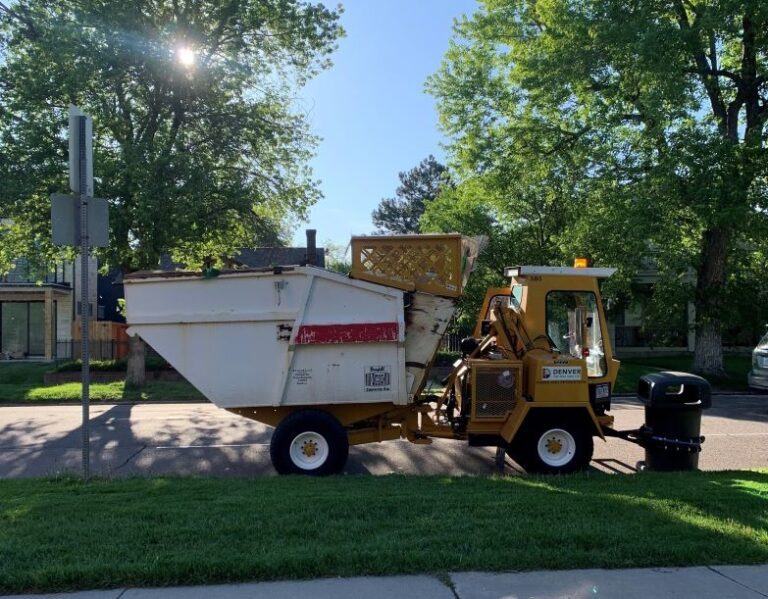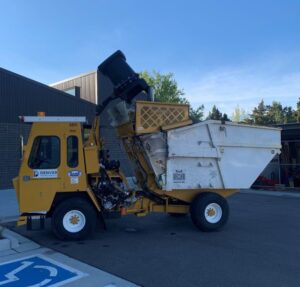By Michael Sabin
It started with the idea of improving efficiency in trash collection for Denver Parks and Recreation. From there it was adapted into a full-fledged, automated trash collection system.
In 2018, Denver Parks and Recreation commenced a pilot program with the objective of reducing the amount of time employees spend picking up and disposing of trash in parks. Denver Parks purchased three automated waste handling machines (in this case, Broyhill Load and Pack).
With these additions, Denver Parks needed to change our existing trash cans – which were 55-gallon drums with a plastic trash bag liner – to a Toter unit. Toter units are made from an “advanced rotational molding,” and do not need a plastic trash bag liner. Denver Parks purchased them in the 60-gallon size.
It was decided that the program would be piloted in the southwest district of Denver, and in 2019 we started utilizing the machines in 14% of our parks (roughly 50 parks). Denver Parks started formulating routes, exchanging trash receptacles, and training our employees on the operation of the machines.
Being in Colorado, we knew the ability to drive the trucks year-round would be tested, and we knew maintenance of the units would be critical to our success. Training included having Broyhill mechanics teach our employees about the maintenance and operation of the machines.
At first, everything ran smoothly. But, as with anything, there were some growing pains – the biggest of which was the new placement of the Toters throughout our parks. Prior to adopting the automated waste handling system, we would drive a pickup truck up to or near the barrel, remove the bag, load it onto the truck and move on to the next barrel. With the trash collection machines, the Toters needed to be strategically placed so the machines could access them and service the Toter. A pivotal aspect of this transition involved the strategic placement of Toters to ensure seamless collection. This required extensive community engagement to garner support for the new trash collection method. Over time, community acceptance grew, resulting in a noticeable reduction in litter accumulation in the parks.
Trash collection routes were developed that would operate seven days a week from late March through October. During this time, the trucks collected, on average, nine tons of trash per week. From November through March, we reduced our trash collection days to three days a week. In the offseason, we collected an average of 3.5 tons per week. On days when it snowed, or the roads were too icy, we would not run the units. Since the program’s inception, we have been able to continue our seven-day-a-week collection during the season. We have also increased our shoulder season collection rate to five days a week, collecting an average of six tons of trash per week.
With any good machine, there is going to be downtime. When we came across this issue where we couldn’t use an automated waste handling machine, we developed a “priority route” that serviced the Toters at the busiest parks and athletic fields. This helped immensely, as these were areas where we historically spent the most time collecting trash by hand. We started to see the benefits of the machines, as employees were not spending all day on Monday picking up trash around athletic fields and permitted spaces.
Since our initial routes were developed, we have been able to successfully expand to cover the entire southwest district, which includes approximately 325 parks and open spaces. The program now operates two routes, five days a week, running the priority route on the weekends. We currently have approximately 400 Toters throughout our southwest district parks. The Toters have allowed us to hold more waste in each receptacle, decrease the overall amount of trash receptacles in parks, eliminate the need for plastic liners, and minimize labor collection of “loose litter.”
The Toters are washed out once per year using pressure washers. This allows us to use heat to ensure we get a good wash the first time, and the need to wash the Toters has not exceeded the once per year standard we have set. We weren’t sure what the demand to clean the Toters would be, but our approach has been effective so far. We wash our Toters in the fall before the weather turns too cold.
With the introduction of the automated waste handling system in Denver’s parks, we have had the opportunity to reallocate funds and labor to better serve our park users. Since we no longer use plastic trash bag liners, we have saved more than $45,000 since 2018. We have been able to reduce the amount of time our employees spend hand-collecting trash, and, since 2019, have saved roughly $120,000 on time spent collecting trash.
One of our primary goals was to determine what else we could accomplish if we are not spending so much time driving around from park to park collecting trash. Denver Parks and Recreation determined that with employees not having to pick up trash daily they have been able to attribute more than 3,000 hours to turf work and detailing in our parks. We have also been able to add more time spent maintaining our flowers and shrub beds (exceeding 900 hours of additional work in these areas). We have also had more time to address general maintenance needs such as graffiti removal and trail maintenance. With the eventual expansion of this program across the city, the opportunities to continue saving and redirecting the time and effort of our staff will continue to improve our maintenance practices. Yes, there is an initial investment in the automated waste handling trucks and the Toters, but the benefits over time make this a worthwhile investment.
We have also been able to reduce the number of trash-collection-related injuries on the job. This has resulted in fewer workers’ compensation claims and less time employees can’t perform their jobs due to injury. With the use of the machines and the decisive placement of the Toters, we were able to remove dumpsters out of our park system. This was done over time, but the phased removal of dumpsters from parks not only mitigated illegal dumping but also aligned with Denver Parks and Recreation’s overarching objective of promoting responsible waste management practices.
Overall, the automated waste handling system has met one of Denver Parks and Recreation’s top priorities, which is “addressing waste more efficiently, increasing user responsibilities, and expanding recycling in parks and recreation facilities.” With properly trained team members, functioning machines, and a positive outlook for expected outcomes, this goal is well on its way to being achieved.
Michael Sabin is the parks manager in the southwest district for Denver Parks and Recreation. Sabin has been in the landscaping industry with an emphasis on turf management for more than 15 years, and has been with Denver Parks and Recreation for the past 11 years. His current role as parks manager has him overseeing the general maintenance and construction of roughly 1,000 acres of parks spaces. This includes 600 irrigated acres with numerous softball, baseball, soccer and multi-use fields. He is also currently on the board of directors for the Colorado Sports Field Management Association.



